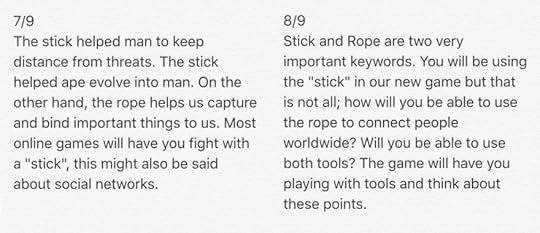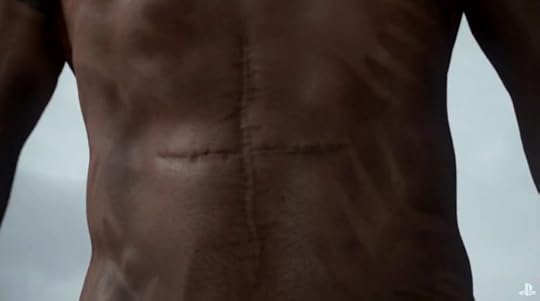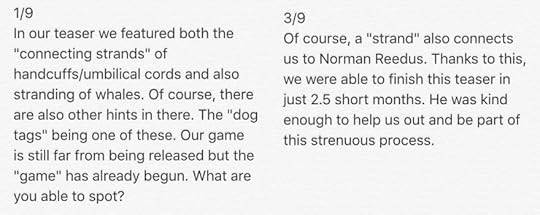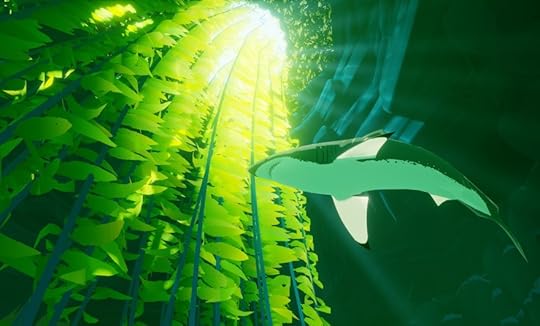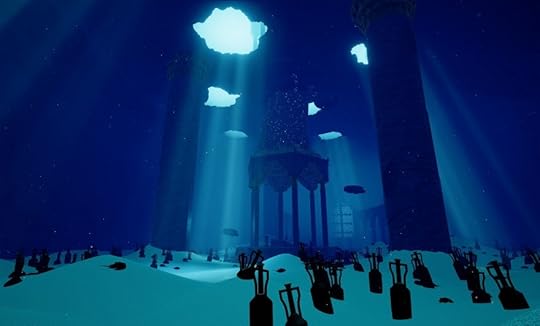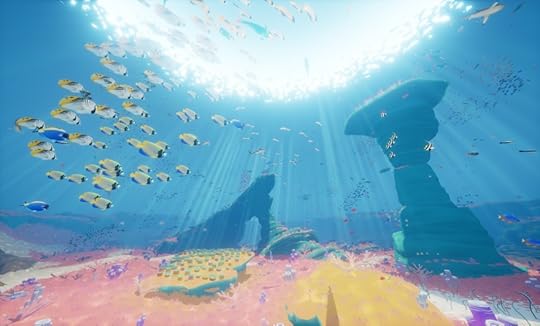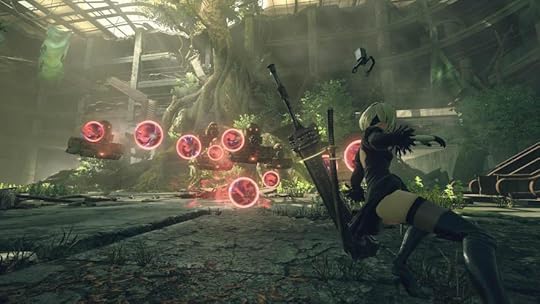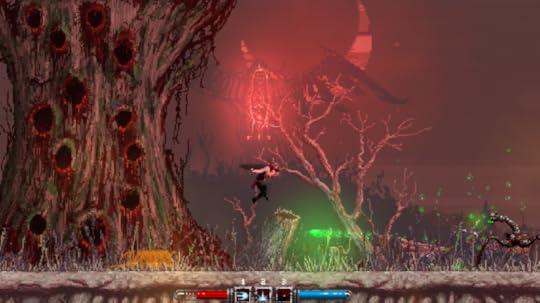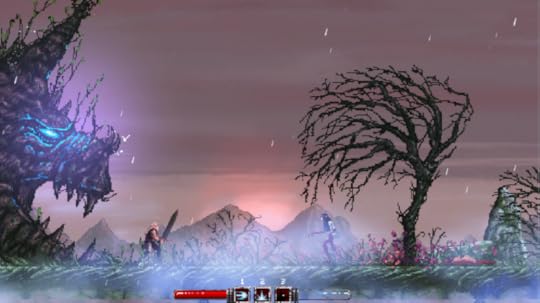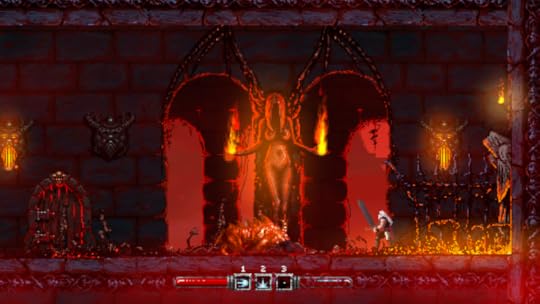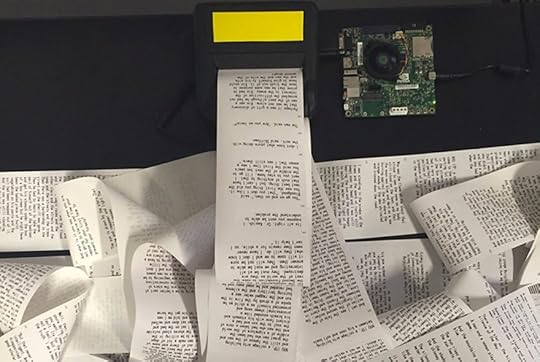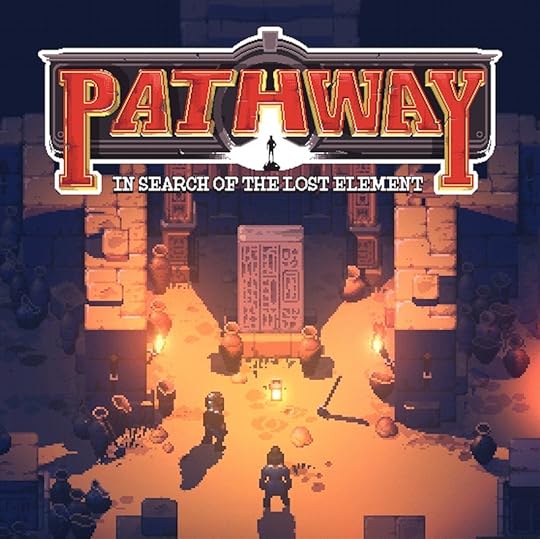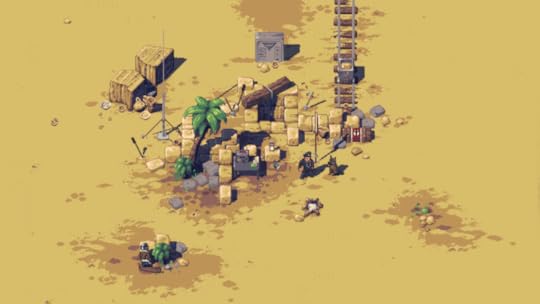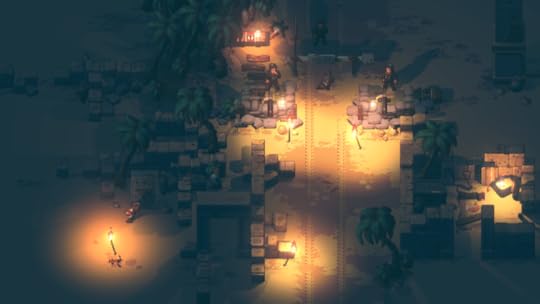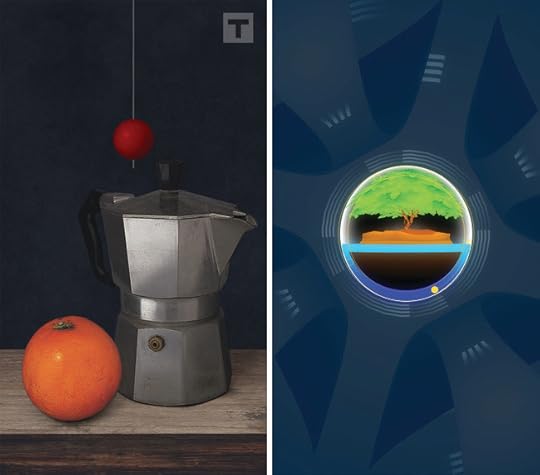Kill Screen Magazine's Blog, page 103
June 20, 2016
Death Stranding: The Ultimate Theory
The trailer for Death Stranding, revealed last week during E3, is proper batshit. It features a naked Norman Reedus clutching a baby to his chest while crying (that has seemingly been delivered by him via c-section, and is still attached to him by the umbilical cord), lots of dead fish, and five distant figures in the shape of a cross floating in the sky. This isn’t too surprising given that it’s the work of longtime Metal Gear series director Hideo Kojima. For years prior to this, he has been working under Konami, producing games that involve prison escape with a bottle of ketchup, a woman who can’t wear much clothing because she breathes through her skin, and a man who literally shits himself during a mission.
But it seems Konami was only holding Kojima back, and now that he is off his leash, he’s having a lot of fun, mostly by encouraging his fans to speculate wildly as to what Death Stranding will be about. In fact, last Thursday, the Kojima Productions Twitter account reeled off a nine-part summary of the answers Kojima gave during press interviews, further feeding fan theories. The first of these tweets starts “In our teaser we featured both the ‘connecting strands’ of handcuff/umbilical cords and also stranding of whales. Of course, there are also other hints in there. The ‘dog tags’ being one of these…” so you know the rest of them are gonna be good. They are, of course, and we decided to indulge Kojima and his team and put together what might be the ultimate Death Stranding speculation (although it’s hard to top this). Sit your bare ass down in the sludge and listen up…
///
The S in STICK appears to be a winding river, like the river of life. Without the S for the river of life, TICK signifies the ever present march of time.
The stick represents violence—sticks and stones. Whereas the umbilical cord is a symbol of motherly comfort—the nutrients we receive from our roots—the life force that sustains us.
Perhaps the umbilical cord is Kojima’s ability to sustain himself—the never-ceasing life support given by fans and the Metal Gear community; his baby, Metal Gear, has been taken from him.
Or the baby is your sins and deeds, born anew. And since the baby is sin, it has to be purged in oil.
The C in umbilical CORD represents the cresting wave of freedom, a common theme in Kojima’s works. The ORD, of course, stands for ordinance, so we can be sure that there is lots of, like, blowing shit up.
We invented STICK and nobody can take that from us. Stick : cord :: fire : light bulb.
STICKCORD
Name of new protagonist. Solid Snake = Stick Cord
The incisions of a botched C-section. A T-section. Or X-section. Exsection is a word=cut out.
So maybe the C stands for the C-section on Norman Reedus’ belly, which is actually shaped like a CROSS, which also starts with C, and is like the first letter in CHRIST—this connects it to the cruciform five floating in the sky at the end of the trailer.
The virgin birth.
Original sin transmuted to man, not womankind.
Miscarriage.
Blood becomes oil.
Oil is the lifeblood of civilization.
What do the hands represent, though?
The hands are the hours of work he spent on projects Konami wouldn’t let him do—ruined and yet washed by oil.
The handprints are the demands of the fanbase.
The thousands of great ideas left stranded.
Maybe Death Stranding is an anagram. Maybe it’s all anagrams.
STICKCORD = DOG TRICKS
STICKCORD = DIRT COCKS
N Reedus….
He’s asking “who R they”
And he N… eedus… to help!
…
NO MAN READ US
He’s naked cause he’s given everything to his art. He’s naked because he is also a baby. His butt cheeks represent rebirth. The baby is a grown man. But it turns into oil (the source of production) to create this new project.
The roundness of life.
The butt cheeks are all of us.
The suppleness of a second chance.
One cheek per chance.
Reedus is a failed scientific experiment to allow men to give birth. Death Stranding‘s main mechanic will be to connect to other beings and attempt to give life where it cannot exist.
The five Metal Gears watch from the distance, Users of the Sticks, casting a long shadow over Kojima’s need to create with the umbilical, stranded on the shores of art…
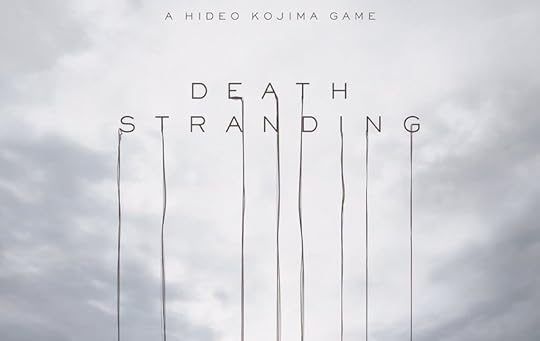
The letters with ropes coming down are EAT STANDING.
Bipedalism.
The truth is out there. And it’s a standing desk.
Wait, no. The AND doesn’t have strands at all. It’s EATS TING.
EAT STING.
TANGIEST.
SAINT GET.
SAGE TINT.
AT GET SIN.
TASTE GIN.
Gotta be it.
The post Death Stranding: The Ultimate Theory appeared first on Kill Screen.
The dream behind Abzû’s alluring underwater world
The “dream” of scuba diving is separated by the actual, body-in-water act by one significant detail: there is no equipment. To scuba dive, you must submerge with a wetsuit, mask, flippers, then there’s the air cylinder, compass, line cutter, and dive light. There’s more too and it all bears down upon you; a heavy baggage of artificial stand-ins for fish parts and safety measures that account for inevitable human error. Matt Nava wants away with it all. He wants to swim nakedly under the sea—bold and free. Drowning not included.
Nava has been scuba diving since high school. He described it as “super fun, transformative” and “the best thing [he] ever did.” He didn’t hesitate to say that it changed his life in an instant. The appeal of scuba diving, at least for Nava, is that it lets you enter “this other world”—he put huge spaces between those three words when he said them, as if each one was a slow, steady step on the moon. And, unlike the planets that orbit the Sun, the ocean is populated with life to interact with, to tease out, to slap fingers against fins in cross-species acknowledgement of the radical capacity of the deep blue. There’s a lot of shit going on below the waterline—we want in.
Abzû has been Nava’s project to realize his scuba diving dream for the past three years. He started it by himself after the team he worked with at thatgamecompany on Journey (2012) disbanded. Journey was his second videogame project, for which he was art director, the first being the studio’s 2009 petal-in-the-wind game, Flower. Everything that Nava has learned about games came from his experience at thatgamecompany. If you look at the opening desert scenes in Journey you’ll notice that the sky there isn’t blue as you’d expect, but a very odd shade of green. This is Nava’s doing. He had built a sequence of gradient colors that would guide the hues and tones of the game’s progression. This sequence placed light blue—the blue you’d use for the sky—right at the end, the idea being that this refreshing color was a visual reward for the player who had reached the game’s finale. And so while a green sky makes no real-world sense, it fitted Nava’s vision, and so it was.
the dolphins can’t help but join in
The green sky was born of one of the prominent ideas Nava carried over to his new studio, Giant Squid: drawing representational curves for the levels or locations of a game before even making a 3D model. These curves represent scales of tension and subtlety, and they guide everything from the speed of movement to the dominant colors in a space. The higher the point of a curve the more intense the scene, with the dips representing an effort towards calmer, more meditative sequences. “We have those at all different scales in the game… throughout this entire level there’s a curve, but then in each room we have a curve, and over the entire course of the game there’s this really big curve,” Nava said.
He said this just after one of the enforcers of this curve showed up: a great white shark. The E3 demo of Abzû opens up with the most serene waters to ever grace an electronic screen. You swim with schools of fish in a sparse blue expanse, then move to a dingier green area where underwater weeds waggle like tapestry in the wind, where sea turtles can be gripped by the shell for a ride, and where a drone can be revived to follow you around with a handy flashlight that illuminates the darker caves. And it is all guided by Nava’s abstract vision of scuba diving, meaning that, unlike a diving simulator, there is no air gauge to think about, and you’re absolutely acrobatic and agile in the water. One of the stand-out movements available to the game’s swimmer is being able to jump out of the water in an arc, just for a moment, traversing the two worlds of liquid and air—the dolphins can’t help but join in. Then the distinct silhouette appears; cut with a knife, gun-metal grey, a weapon in the water. The great white is here. The curve shoots upwards.
Since at least Steven Spielberg’s Jaws (1975), the great white has been an easy motif for danger in the water. Perhaps it’s a little too easy. It’s why Nava wants to challenge that preconception… slightly. “The great white shark is this, you know, very iconic fish that we all know and fear,” he said. “In Abzû, we saw this opportunity to show more sides to the great white shark, represent it more as this powerful beast that you have to respect.” Hence the shark won’t immediately attack you—in fact, you cannot die in Abzû—but you should show an appreciation for its place in the game’s ecosystem. It is the dominant predator after all. And it is truly an ecosystem that Abzû has for you to interact with. While scuba diving has been abstracted into a dream, the fish in the game and how they group together, even how they swim, hits simulation levels of mimicry.
Every single fish belongs to a biome that represents its real-world habitat around the globe. The demo area is based on the kelp forests off the coast of California, and so you can watch as a goliath grouper fish eats the smaller fish, a bat ray moving like a graceful dancer in the background. There’s even a “meditation mode” that’s activated by sitting on certain statues, from where you can put the controller down and watch the fish swim by as it if were a virtual aquarium, the names and species of fish popping up for you to get familiar. The knowledge you pick up here can be used outside of the game. That’s why Nava and team went so far as to put a working simulation of the food chain in Abzû—it’s a topic that gets Nava particularly giddy. “You see these other games with fish but you never see them eating each other. And it’s like, that is what fish do … you need to have that,” he said. “So we’re really excited to have that in the game. Sometimes, if you’re riding a smaller predator, they can be eaten right out from under you, which is awesome.”
“what’s down there?”
Besides fish facts, there’s another reason to drift into the darker recesses with your drone. This is where the secrets can be found. As Nava showed on-screen, you can happen across places where the kelp has decayed, where there is no light, and by interacting with the strange architecture to be found within, you can briefly enter a more magical water world. “The ocean is this place that, you know, is very unexplored, and I think that we all have in our imaginations, like, this sense of mystery about it, and we wanted to include that kind of surreal magic that you think about, like, ‘what’s down there?’, in the game,” Nava said. As he did, the diver and their drone returned and brought with them 10,000 fish that suddenly filled the entire “room” (as Nava calls it).
And that number is no exaggeration. As Nava explained, one of the team’s engineers had to rethink how they animate characters to achieve this many fish on-screen at once. “If we had gone with the traditional method of creating an underlying skeleton that deforms the character, you can only have 100 fish on the screen,” Nava said. “And then one of our engineers figured out that, hey, if you take away that internal skeleton you can still animate them with, like, mathematical formulas. And doing it that way is much cheaper and we can have thousands of fish.” This meant that, in one night, Abzû‘s ocean populace suddenly became one hundred times its previous size—”that was a good night,” said Nava. “It was fantastic.”
The Abzû demo comes to a close by teasing what else is to come as you gradually descend the ocean depths. First, there are glyphs to find that uncover a culture that has been lost, which Nava said also begins to make connections to how the swimmer you play relates to the history of this world. Then there’s a giant mechanical structure, completely out of place among the weeds and coral, that grants you entry to the next biome. Each progression creeps closer to an abyss, one that’s forecast through an increasing murkiness in the water, gradually blocking out the light from above. This encroaching blackness enacts the game’s biggest curve, ramping up the tension. “We’ve had playtesters who have been freaked out by just being in these dark environments,” Nava said. “It’s really cool to be able to manipulate the player’s sense of space and use that to create these kind of stories.” But it’s not the gloom alone that carries this sense of foreboding because, as Nava teased, there are larger creatures to be found below.
“What is your favorite fish?” we asked.
“Oh man, there are hundreds of them,” he replied. “It’s hard to choose, but some of the larger creatures are really majestic.”
“Is there a giant squid [in the game]?”
“I don’t wanna spoil it but we definitely do have cephalopods in the game, so … you can take a wild guess.”
Abzû is due to come out for PlayStation 4 and PC on August 2nd.
This article was based on an interview with Matt Nava conducted by Clayton Purdom.
The post The dream behind Abzû’s alluring underwater world appeared first on Kill Screen.
NieR: Automata’s new footage is all bullet hell and deadly androids
The Drakengard action-RPG spin-off Nier (2010) wasn’t a critical or commercial smash when it was released six years ago. It was just kind of… there. Neither terrible, nor great, its wieldy story was praised, while its lackluster visuals and janky combat left a lot to be desired. Nonetheless, Nier became an unlikely cult classic, which steamrolled players’ desire for a sequel. And now that sequel, the PlatinumGames-helmed NieR: Automata, is nearly here.
During E3 2016, a year after the project was first announced, a release window (early 2017) and extensive footage for NieR: Automata was showcased. A boss battle teaser and a full trailer later, NieR seems to be shaping up to be an improvement upon its divisive predecessor. In the Nier follow-up, the player will be able to play as multiple characters as the story progresses, most prominently shown as a cute, but deadly, android.
The best bullet hell games are the most chaotic. There’s the Touhou series, a Japanese-bullet hell powerhouse whose surrounding culture is more honed into its story, characters, and hyperactive music. The games themselves, however, are often plagued with immense difficulty. In the first Nier, bullet hell-esque boss fights inched their way in, possibly a first at adapting the commonly 2D-sidescrolling genre into an action-oriented, 3D-roamable dimension. In its sequel, NieR seems to take this bullet-chaos a step further.
The best bullethell games are the most chaotic
PlatinumGames’ last few titles may have been less than stellar, but watching the insanity of bullet hell-style bosses mechanize in a 3D setting makes it appear that the shift to PlatinumGames benefited the series. And who knows, maybe NieR: Automata will be Square Enix’s answer to the goofy and exhilarating PlatinumGames-developed Metal Gear spin-off, Metal Gear Rising Revengeance (2013). With core creators of the original game working on the game, players can surely expect a similar (but hopefully improved) experience.
Frantically dodge bullethell bubbles when NieR: Automata is out in early 2017 on PS4.
The post NieR: Automata’s new footage is all bullet hell and deadly androids appeared first on Kill Screen.
Slain! is a disappointing death growl
Heavy metal is the musical and theatrical manifestation of mankind’s lizard brain. It’s an auditory siege that rifles through our ancient and violent nature that was once necessary to survive. This music transmutes those base emotions through myth, metaphor, and performance through modern instrumentation, impossible without electrical amplification. The costumes vary from latex to bullet belts, corpse paint to standard issue black, and on the stage the lights are kept low or flashing. Every note and image is calculated and well-rehearsed, because metal thrives in the extremes and requires complete attention to maintain the shared illusion for everyone at the show.
But heavy metal also rides a thin line between serious and silly, and it takes very little to disrupt the collective vision shared between band and audience. The metal-themed arcade-action game Slain! is draped in the iron and blood of metal and melee games, but stumbles over itself by playing too close to the standard tropes of each. It coasts on lip-service and too often exposes the seams between fantasy and reality that both games and heavy metal require to thrive.
Kickstarted to success due to an auspicious art design, Slain! is drenched in rivers of gore, shrouded in the darkest goth undertones, and framed with choice windmill gifs. The spirits of Mayhem and Watain were summoned and put to pixels with a “Carpathian forest in late Winter” filter. Early videos promised something meticulously bleak and brutal, with visual references to orchestral metal videogame touchstones like Castlevania: Symphony of the Night (1997) in all the right ways. And Slain! delivers on its optical oaths. Blood and viscera drips, explodes, splashes, and sprays from every enemy and nearly all surfaces; magic glows and pops from the screen; most enemies throb and lurch as lurid mannikins mocking the fragility of humanity. It’s a hideous cauldron boiling down the spectrum of metal into a viscous on-screen ooze.
This thrash abattoir wallpaper is tacked over a side-scrolling arcade brawler frame, the tract housing of videogames. Such a house does its job with mere adequacy: putting walls between you and nature’s howling winds and baying coyotes, a roof that blocks harmful UV rays and acid rain, a garage that stores guitars unplayed and amps never plugged in. Similarly, Slain!, affectionately nuzzles Altered Beast (1988) with a werewolf stage, cribs Ghosts ‘n Goblins (1985) for slight weapon variations and cemetery appeal, and nods respectfully towards the original Castlevania (1987) for everything but the ham. Which is all to say that you’ve played this game, with slight updates and adjustments, for nearly 30 years.
You are cast as Bathoryn, a Norse-ish warrior who is pulled from the sweet sleep of death to (once again?) face demonic hordes, with hints of redemption and revenge as his motivation for unleashed barbarity. When Slain! was first released it was an “early access” title in everything but name, a borderline unplayable one at that. Since then a few patches have balanced what was initially a sword of felt and unstoppable spongy eldritch nightmares, resulting in a much more enjoyable stroll through Baphomet’s campground. The way to use magic is clear, Bathoryn has mastered a parry and riposte that is thuddingly satisfying, and the difficulty scales from peon to end-stage generals on a more logical spectrum.
The structures Slain! sends you through are mundane—consisting primarily of x/y Cartesian planes with timed platforms, where you experience the thrill of waiting for a floating Uber. As such, a formula emerges: crush monsters, linger around for a platform, jump over blood pits and traps, maybe even stroll contemplatively for a spell, repeat. These stages aren’t horrendous, but no one will accuse them of being inspired, and there is nothing more boring than by-the-numbers metal or level design. Time has not been kind to the baseline beat ‘em up genre, which requires only strolling around single-mindedly with an occasional attack or jump.
The formula goes: Monster, linger around for a platform, jump over blood pits and traps, repeat.
Slain! fails to juice the established arcade recipe, though, to be fair, no one shreds on their first pass over a fretboard. It’s a serviceable, basic game, which just means that it requires the theme and dressing to really shine. As such, it’s quite disappointing that the writing and music are almost parodying heavy metal source culture rather than paying tribute. The dialogue seems to have been lifted directly off the geometry folder of a high school hesher or an Odin-centric fanfic blog. It would be laughable if it didn’t give me a headache from rolling my eyes so hard, a pain exacerbated by the generic chugging of the soundtrack, more nü-metal than true kvlt.
The script and soundtrack of Slain! are tone-deaf and distracting; no writing at all would have been preferable and there are plenty of much more compelling and thematically appropriate long-form doom jams one can throw on the turntable while playing. There’s no doubt that metal can be cheesy, but it’s a mostly self-aware swiss, a performance of overblown aggression that at its best is a nuanced reflection of society’s hypocrisy and a font of institutionally repressed emotion. Slain! embraces only the aspects of metal that inspired Tipper Gore’s misguided helicopter-parent fear in the 80’s, as if it believed a “Parental Advisory: Explicit Content” sticker and pissing off your parents are where extreme music begins and ends.
Slain! reveals itself almost immediately as a demo tape with a splashy cover, a composition in progress that carries a spark of potential buried in the mix. It does not live up to the promise of its visuals, instead merely keeping pace with its influences white not daring any attempt to surpass them. There is some potency of its aesthetics that closely align with the indubitable garishness of black metal, but the writing and soundtrack lack a refined understanding of the metaphorical mirror metal holds up to civilization. Slain! is a poser, well-dressed and intentioned but vacuous, contributing nothing to the scene. It has the spiked gauntlets, the long hair, the denim jacket; but the house lights are on and everything’s out of tune.
For more about Kill Screen’s ratings system and review policy, click here.
The post Slain! is a disappointing death growl appeared first on Kill Screen.
June 18, 2016
Weekend Reading: Dr. Adults and Mr. Teens
While we at Kill Screen love to bring you our own crop of game critique and perspective, there are many articles on games, technology, and art around the web that are worth reading and sharing. So that is why this weekly reading list exists, bringing light to some of the articles that have captured our attention, and should also capture yours.
///
Lois Duncan’s Teenage Screams, Sarah Weinman, New Republic
Lois Duncan, a young adult writer known for Killing Mr. Griffin (1978), Summer of Fear (1976), and I Know What You Did Last Summer (1973) passed away earlier this week at 82. Sarah Weinman reflects on the influence and context of Duncan’s work, which took teenage anxieties and rewound them into tales of terror.
The Strange Case of Dr. Jekyll and Miss Osbourne, Alison Taylor, Senses of Cinema
Dr. Jekyll and Mr. Hyde (1886) has become more than the gothic novella written by Robert Lewis Stevenson but almost its own archetype, a kind of ubiquitous fable about substance and duality. Yet somehow Polish filmmaker Walerian Borowczyk’s interpretation of the text remains especially shocking, and Alison Taylor believes that some of this is due to the fact that the director adapted not only the text, but some of the intrigue behind its creation.
Photo credit: Hilary Swift for The New York Times
Ingress Has The World as Its Board Game, Vindu Goel, The New York Times
Ingress, an augmented-reality game released in 2013, turns cities into team sports, and boasts a player base around a million strong. Much of its design is being implemented in the highly anticipated Pokémon GO, but as Vindu Goel explores, the human error in this game’s design can lead to a much weirder state of play.
What Happened to ‘The Most Liberated Woman in America?’, Alex Mar, Longreads/Atlas Obscura
Alex Mar, author of Witches in America (2015), visits the Nevada Desert home of Barbara Williamson, co-founder of the Sandstone Retreat, America’s most famous sex commune established in the tail end of the 60s. So yeah, things get a little strange.
///
Header image via New Republic
The post Weekend Reading: Dr. Adults and Mr. Teens appeared first on Kill Screen.
June 17, 2016
Short sci-fi film written by an AI is absurdly human
Artificial intelligence is a common topic explored within the science-fiction genre. Sunspring, a new sci-fi short, instead of using the theme of artificial intelligence in its narrative, used AI to actually produce the narrative in the first place. The film, which had its online debut on Ars, had its screenplay written by an AI which goes by the name of ‘Benjamin‘. The film was submitted as part of the 48-Hour Film Challenge at the Sci-Fi London film festival by Oscar Sharp, a BAFTA-nominated filmmaker and Ross Goodwin, a creative technologist and former Obama administration ghostwriter.
Sunspring comes to life through the acting and production. The screenplay is sufficiently vague and nonsensical to leave a lot of room for interpretation. The actors, Elisabeth Gray, Humphrey Ker and Silicon Valley‘s Thomas Middleditch give the screenplay an entirely new life, acting out a love triangle plagued with complex dynamics of hurt and uncertainty. As Sharp tells Ars, in reference to the fact that a love triangle seemed so obvious to them, despite it not in any way being explicit in the text, “Maybe what we’re learning here is that because of the average movie, the corpus of what we’ve watched, all of us have been following that pattern and tediously so…We are trained to see it, and to see it when it has not yet been imposed”.
there is something uncanny about an AI reproducing uncertainty and anxiety
Something which sticks out in the writing of the screenplay is the continued assertion of “I don’t know” throughout the piece, said by every character. This uncertainty, or inability to understand what’s happening, is something Sharp says is in a way inherent to a speculative genre, where characters are “…questioning the environment, questioning what’s in front of them. There’s a pattern in sci-fi movies of characters trying to understand the environment.” Considering this screenplay came from an AI which was informed by other sci-fi material, this larger connection to the genre is a clear link to make. However, there is something distinctly uncanny about having an AI so powerfully latch onto this term of uncertainty and anxiety in the face of having to produce a unique creative work—a feeling all creators can in some way relate to.
Our interest in the ability for AI to be creative, a quality so closely associated with sentience, continues to play out in many different ways. There’s been an especially massive amount of inroads made with algorithmic music composition. However, the complexity of language and story production is incredibly difficult for AI to accurately emulate. Although this has acted as barrier to developing algorithmic story production, Alexis Kirke, a filmmaker and composer who has also dabbled in screenwriting algorithms, says, “The truth is, we’re not as good at doing this as we are at using computers to write music. And this has put many researchers off. However, unless we begin to take steps in this direction, how will we ever make progress?”
Sunspring is a reminder of how strong our desire is for making sense of things that are foreign to us, like artificial intelligence, by making them seem more familiar. Despite the fact that, as Sharp notes, we are prone to reproducing patterns we are used to, an AI like Benjamin, allows us to imagine new, different, and unexpected modes of creative production of the future.
Header image is a still from the film. Be sure to check out Sunspring, and keep track of Benjamin’s work through its website.
The post Short sci-fi film written by an AI is absurdly human appeared first on Kill Screen.
Chase Nazis and lots of other stuff in an upcoming 1930s pulp adventure game
Germany-based developer Robotality, who worked on the space colonization simulator and grueling strategy game Halfway (2014), have described their newest project as a “tactical RPG set in a 1930s pulp adventure scenario.” Like many good sentences that say little, their description opens up a world of possibilities.
Take an Indiana Jones artifact hunt with a motley crew of outsiders and eccentrics, add a newly-discovered chemical element with unknown properties that’s only spoken of in whispers, and throw in a few Nazi agents racing toward the same prize for good measure. You’re getting close to what this game is all about.
Pathway wants to be everything
Pathway: In Search of the Lost Element, scheduled for a 2017 release, wants to be everything. It’s beautifully illustrated with what Robotality fondly refers to as “next-gen pixel art,” a voxel-pixel hybrid that allows for dynamic shadows and lighting while sticking to the classic aesthetic. Sneak peeks reveal the Reich’s soldiers lurking in desert ruins and structures reclaimed by an encroaching jungle; it teases the mix of sci-fi and historical exploration promised by a game that wants us to look for landmark scientific discoveries in a haunted tomb in the ’30s. Robotality are building on what they learned with Halfway—another a turn-based tactics game—to give the appeal of pixels and the challenge of strategy a new twist.
Though Pathway wants to somehow combine dime novels with Tomb Raider (1996) while also mixing in that one Tesseract scene from the first Captain America movie, the result looks surprisingly… charming. Pathway’s stylized art and earnest embrace of the concept gives the historical aspect of it room to breathe. Of course, you have to beat the Wehrmacht to get to the nerd equivalent of buried treasure. Of course! You look at their charming DOS-inspired logo or the little pixelated German Shepherd sitting in the stand with its tongue sticking out and it just makes sense.
It’s not asking you to sit down and voluntarily think about a world where the Axis powers won WWII. It’s not wondering if the perpetrators of some of the greatest atrocities in recent memory would have been cooler if they’d had lasers. It’s not fucking Nazi Zombies. It’s light, and it’s pulp, and it’s pixels.
Check out Pathway on its website , and follow Robotality’s updates on Twitter .
The post Chase Nazis and lots of other stuff in an upcoming 1930s pulp adventure game appeared first on Kill Screen.
Download a virtual art exhibit that features original games from around the world
La Triennale di Milano is an Italian modern art and design museum, focused on the relationship facilitated through art and industry. The La Triennial di Milano regularly displays exhibitions of design, architecture, art, fashion, film, and essentially anything contemporary. After a 20-year absence, the Triennale International Exhibition has made its triumphant return. With events and exhibits widespread across Milan, and now even an app-bound virtual exhibit by game designers from around the world, the Triennale International Exhibition has truly been ushered into the modern era. And after two decades away, that’s much to be revered.
The chance to see art from the most accessible place in the world—handy-dandy phones
The iOS-based Triennale Game Collection is a virtual art exhibition of sorts. The app features five unique videogames, with a new interactive piece on display per week. The Collection was curated by Italian experimental game designer Pietro Righi Riva. The Santa Ragione studio-powered virtual space hosts the variety of games centered on puzzles, exploration, and even interactive narratives.
The first week’s game comes from Switzerland, with Plug & Play (2015)—one of our favorite games of last year—creators Mario von Rickenbach’s and Christian Etter’s bite-sized story about a lonely cord. Other designers to be featured in the ongoing exhibition include Belgium’s Auriea Harvey and Michaël Samyn of Tale of Tales (creators of last year’s Sunset); Jake Elliott, Tamas Kemenczy, and Ben Babbitt of Cardboard Computer (most notably of Kentucky Route Zero fame); France’s Pol Clarrisou, creator of last year’s death-intrigued Orchids to Dusk; and United States-based artist and game designer Katie Rose Pipkin.
The Triennale Game Collection doesn’t have a throughline with its catalog—just in that all its quaint videogame vignettes are quite singular, and balance how different games can be, even with shared ways to play. When these experiences originate from multifaceted creators from all across the world, new art experiences are able to blossom. Since it’s doubtful that everyone in the world that is interested in physically seeing the Triennale International Exhibition for themselves can actually travel to Milan, the Collection now gives viewers the chance to see art from the most accessible place in the world—their handy-dandy phones.
You can download the Triennale Game Collection for iOS and Android phones, and is available for free . Be sure to check back weekly for its new exhibits.
The post Download a virtual art exhibit that features original games from around the world appeared first on Kill Screen.
A game about the difficulty of getting people to leave a house party
Knowing how to leave a party is an important life skill. This does not get enough attention. Plenty of angst and instruction and practice goes into mastering the entry: when to arrive; what opening line to use; what to bring. As for the exit, well, you’ll figure that out when the time comes—just feel the room. Everyone will probably be sloshed by then anyhow.
That system tends not to work and, consequently, most parties stumble across the finish line like a marathoner who ran the opening mile at full speed. People stick around too long; they fall asleep; they pass out. Pity the poor host who has to deal with this mishegas. Pity every host, for that matter.

Party Pooper, a new web game from London’s Animade, empowers a fictional host to do whatever it takes to clear their home. Sure, the narrative stakes are tilted in the homeowner’s favor—they didn’t even plan the party and came home to find a bunch of revelers in their kitchen. The situation is nevertheless relatable; at the point where you’re trying to end a party, everyone feels like a home invader.
make the guests miserable enough to leave
Party Pooper gives you more options than the average host. The kitchen is strewn with objects that you can—and will—use to make the guests miserable enough to leave. Everyone has a weakness. You can find out what it is by clicking on them. One guest is sensitive to noise, so you pop some balloons. Another is sensitive to temperature, so you smash a window with a hammer. Clearing your house involves considerable collateral damage, but Party Pooper acknowledges that it might be worth it to find some peace and quiet.
There is a competitive aspect to this game. It is a race. The faster you clear out the guests, the better. This is a game of speed and skill. Yes, I said skill. Clearing a party is a skill, and one that should be taken seriously. Party Pooper doesn’t really teach you how to take anything seriously, but hopefully it is a first step in that direction.
You can play Party Pooper right here.
The post A game about the difficulty of getting people to leave a house party appeared first on Kill Screen.
Sequel lets you easily build your own chatbot, so go wild with it
Dating back to when Alan Turing wrote his famous article “Computing Machinery and Intelligence” (1950), in which he first presented the concept of the Turing test, chatbots are a technology that has become popular once again, now being developed for entertainment, mediatic and customer services ends. From the historical chatbots (also known as chatterbots) ELIZA (1966) and PARRY (1972) to more recent initiatives like Cleverbot and SimSimi, or even the Facebook Messenger game Jessie’s Story, now there is a new chance for independent writers, game makers, and brands to work with this technology by using a new chatbot platform, Sequel.
Launched on June 2nd, Sequel is a new project from the mobile games company Kiwi, Inc. It gives you the means to create your own bots for media and entertainment purposes, making use of leading messenger apps such as Facebook Messenger, Kik, and Telegram. Features include natural language processing (NLP) and web service integration through API nodes.
According to Kiwi, Inc CEO Omar Siddiqui, Sequel enables people to build personas, not just bots. “Whether you’re a big industry giant or a smaller indie writer, Sequel gives you the opportunity to have meaningful conversations directly with your target audience, connecting them emotionally and creating a long-term relationship in a messaging space,” he says.
Communication has drastically changed over the years, with text messages becoming one of the easiest and most common ways to communicate and connect with people. Sequel takes the opportunity to hit an audience of three billion users that, on average, open a communication-related app 17 times (or more) per day — at least once every waking hour. But considering how intimate this form of communication is, the challenge then was to create an engaging and meaningful connection when in contact with a synthetic persona. “Having a mobile entertainment and interactive background, it felt like a natural transition to leverage our expertise and resources for this new medium, focusing on entertainment and media based bots that will appeal to this audience and meaningfully engage them on the platforms they’re already using,” explains Siddiqui.
“The progression of automated conversations will be one of the great endeavors over the next few years.”
In spite of being a recent project, Sequel has some brands already working with their platform. The media and entertainment company AwesomenessTV has created a Kik bot that combines native video and chat to give fans interactive content, while the teen celebrity gossip magazine J-14 is offering a celebrity trivia bot for their readers. Thus, in order to provide truly authentic bot experiences, Siddiqui recommends that writers and brands try to reflect their personality in their chatbots, so they will have “the best shot at satisfying the emotional connection their consumer is expecting.”
On the other hand, Sequel is also a great opportunity for writers and developers that are interested in chatbot-based games and narratives. According to Siddiqui, “storytelling is at the heart of Sequel,” hence his team worked with over 30 award-winning creators — authors, screenwriters, comedians, and game creators — in order to offer quality content for the platform’s launch. For this reason, it’s already possible to find a range of conversational experiences separated by categories, including romance, adventure, sci-fi, crime, thriller, comedy, and more. One of the most popular examples is Probable Cause, formerly known as Detective Kees when available for Facebook Messenger.
Sequel’s intuitive drag-and-drop tools allow the use of text, photos, videos, audio, GIFs, emojis, quizzes, polls, and further interactivity tools when crafting your bot. While in beta, the conversations developed in Sequel will be primarily navigated by users through native UI offered through the various messaging platforms such as Facebook Messenger. However, Siddiqui says that soon they will be launching a new feature that will allow creators to build natural language into their bot experience for true interactivity, if preferred. “This is just the beginning for this medium, and there is a tremendous amount of opportunity for this technology to grow,” he claims. “The progression of automated conversations will be one of the great endeavors over the next few years.”
In terms of inspiration, Siddiqui says that Sequel wasn’t designed after any specific fictional work, even though he and his team are huge fans of Spike Jonze’s movie Her (2013). The project was actually designed after seven to eight years of experience in the mobile entertainment industry, and after creating a number of story-based games. “We realized we needed to build an entire infrastructure for our writers to support these games, from character creation to crafting storylines. This gave us an expertise in the interactive storytelling format,” he says.
Creating your bot with Sequel is free and you can get help from their tutorial videos, a forum and also a Frequently Asked Questions page.
The post Sequel lets you easily build your own chatbot, so go wild with it appeared first on Kill Screen.
Kill Screen Magazine's Blog
- Kill Screen Magazine's profile
- 4 followers


